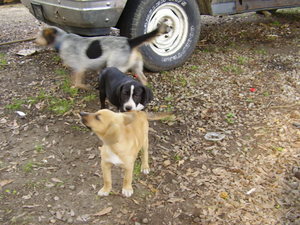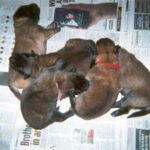Recently a shy mama dog and her even more shy litter of five pups were turned loose. There was food left for them at the back door of the home but they lacked something else. One puppy’s lack of boundaries and training cost him his life when he was hit by a car crossing the street. The mama dog had been swung at by a man in the home and another walking down the street several times. Her fear level showed a pattern of expecting to be hit so she was defensive.
But it was when they ventured into the yard one morning a bigger story came out – I took a bowl of food to try to evaluate the pups and hopefully find them a home before they were also hit by a car. One had already been, another was hit but ok. A little chocolate colored pup has a small hernia. To be less intimidating I sat on a concrete block and with a little time touched and held two of the bolder pups. I stood up to step over them to get them a small bucket of water as it was a warm day – and they all cringed to the ground, eyes on the foot as if waiting for a kick. It was heartbreaking – and they are far too young to know of such things. I decided then they needed more time and attention to be able to be placed in a home.
A few days later the little tan pup was eating and I reached down to pet her…this time she didn’t shrink away. I reached down and picked her up and she set to screaming as if her very life was at risk. Honey, as I called her, was one step from fear biting – sheer terror in her eyes, her body rigidly tense, her eyes wide open – instead of letting her go I held her closer, securely without squeezing her. The only expression she had left was screaming and after a minute or so when her mind slowed to realize she wasn’t being hurt the scream turned to a whine. She was terrified – too scared to take a piece of kibble and too tense to take food. I took her on the back covered deck and placed her in a crate. The next day again she screamed. The third day she was much better. She’s young and resilient. In less than two weeks her behavior is completely different – she’s eagerly seeking out attention, she’ll crawl up and sleep next to me – initially a comfort it’s also a means of bonding. She’ll come when called now and no longer cringes. It gives hope that her three siblings will find a home also.
Some dogs are naturally more timid and submissive. Others are outgoing and less reactive. A timid dog might cringe and crouch to the ground – without having ever been abused. They might shrink away if an argument or raised voices happen. This kind of dog, abused or not, needs extra praise and TLC. Still other dogs are naturally dominant, outgoing and sometimes even after abuse don’t show many signs. This doesn’t mean they aren’t stressed.
There are some articles done on AC and other places that show some “signs” of abuse or neglect that aren’t always accurate. One stated was the dog who comes in front – a well trained obedience dog will do this. Indeed with a little effort Honey does this. A polite sit places an enthusiastic dog in front rather than jumping up and being out of control. Not everyone appreciates pawprints on their clothing.
Learning dog behavior is something that makes a huge difference. Being consistent means a dog will forgive reprimand quickly – espeically when they also learn that good behavior is rewarded. Dogs go to dog behavior – we have to teach the dog to modify his or her behavior within the acceptance of our realm. The dog easily adapts to the family when he knows that some things are unacceptable – jumping on counters, stealing food, nipping. There are behaviors that can be dangerous to the dog – such as grabbing mouthfuls of food as if starving. Sometimes dogs who have done without will do this; but sometimes dogs who haven’t do it. He must learn to slow down. It’s damaging to his health. A good way to do this is – firstly, feed him good food at a regular time. When he knows there is food coming in the morning he’s less stressed about the next meal. If he bolts his food spread it out – use a large bowl or a clean floor – spreading the food out means he can’t physically grab a big mouthful and wolf it down. He has to learn to slow down. Give him what he wants to eat for 20 minutes or so or, if a measured amount, what is recommended for his breed and activity level.
Dogs also will learn quickly that doing some behaviors, such as sitting quietly for attention or playing with a toy instead of wires and shoes, are met with rewards. They will naturally want to repeat that.
Dog training isn’t rocket science. It’s observation, timing, love and a mix of praise and discipline. Liberal application of this can change a dog’s






